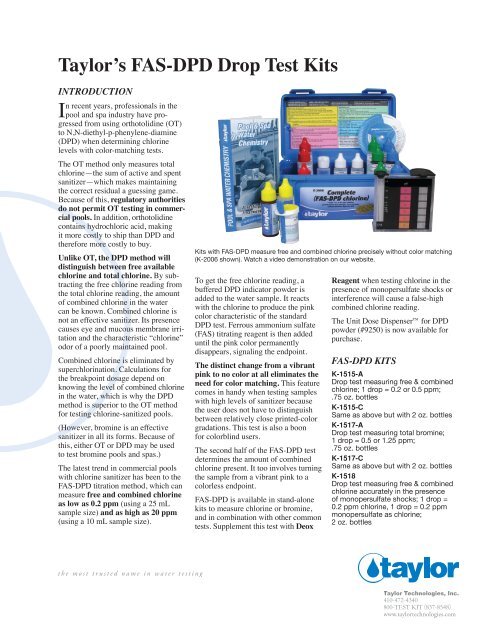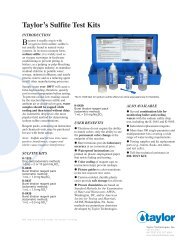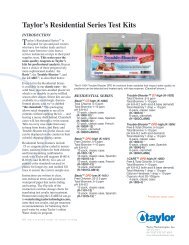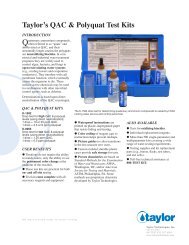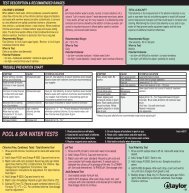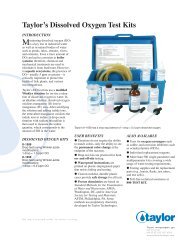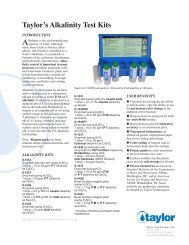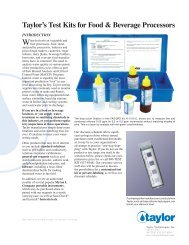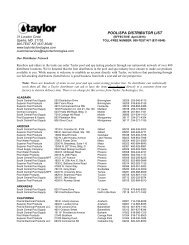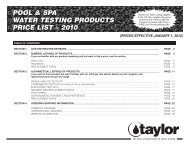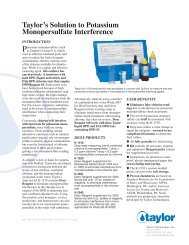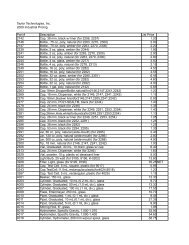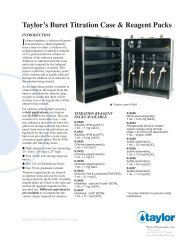Taylor's FAS-DPD Drop Test Kits - Taylor Technologies
Taylor's FAS-DPD Drop Test Kits - Taylor Technologies
Taylor's FAS-DPD Drop Test Kits - Taylor Technologies
You also want an ePaper? Increase the reach of your titles
YUMPU automatically turns print PDFs into web optimized ePapers that Google loves.
<strong>Taylor</strong>’s <strong>FAS</strong>-<strong>DPD</strong> <strong>Drop</strong> <strong>Test</strong> <strong>Kits</strong><br />
INTRODUCTION<br />
In recent years, professionals in the<br />
pool and spa industry have progressed<br />
from using orthotolidine (OT)<br />
to N,N-diethyl-p-phenylene-diamine<br />
(<strong>DPD</strong>) when determining chlorine<br />
levels with color-matching tests.<br />
The OT method only measures total<br />
chlorine—the sum of active and spent<br />
sanitizer—which makes maintaining<br />
the correct residual a guessing game.<br />
Because of this, regulatory authorities<br />
do not permit OT testing in commercial<br />
pools. In addition, orthotolidine<br />
contains hydrochloric acid, making<br />
it more costly to ship than <strong>DPD</strong> and<br />
therefore more costly to buy.<br />
Unlike OT, the <strong>DPD</strong> method will<br />
distinguish between free available<br />
chlorine and total chlorine. By subtracting<br />
the free chlorine reading from<br />
the total chlorine reading, the amount<br />
of combined chlorine in the water<br />
can be known. Combined chlorine is<br />
not an effective sanitizer. Its presence<br />
causes eye and mucous membrane irritation<br />
and the characteristic “chlorine”<br />
odor of a poorly maintained pool.<br />
Combined chlorine is eliminated by<br />
superchlorination. Calculations for<br />
the breakpoint dosage depend on<br />
knowing the level of combined chlorine<br />
in the water, which is why the <strong>DPD</strong><br />
method is superior to the OT method<br />
for testing chlorine-sanitized pools.<br />
(However, bromine is an effective<br />
sanitizer in all its forms. Because of<br />
this, either OT or <strong>DPD</strong> may be used<br />
to test bromine pools and spas.)<br />
The latest trend in commercial pools<br />
with chlorine sanitizer has been to the<br />
<strong>FAS</strong>-<strong>DPD</strong> titration method, which can<br />
measure free and combined chlorine<br />
as low as 0.2 ppm (using a 25 mL<br />
sample size) and as high as 20 ppm<br />
(using a 10 mL sample size).<br />
<strong>Kits</strong> with <strong>FAS</strong>-<strong>DPD</strong> measure free and combined chlorine precisely without color matching<br />
(K-2006 shown). Watch a video demonstration on our website.<br />
To get the free chlorine reading, a<br />
buffered <strong>DPD</strong> indicator powder is<br />
added to the water sample. It reacts<br />
with the chlorine to produce the pink<br />
color characteristic of the standard<br />
<strong>DPD</strong> test. Ferrous ammonium sulfate<br />
(<strong>FAS</strong>) titrating reagent is then added<br />
until the pink color permanently<br />
disappears, signaling the endpoint.<br />
The distinct change from a vibrant<br />
pink to no color at all eliminates the<br />
need for color matching. This feature<br />
comes in handy when testing samples<br />
with high levels of sanitizer because<br />
the user does not have to distinguish<br />
between relatively close printed-color<br />
gradations. This test is also a boon<br />
for colorblind users.<br />
The second half of the <strong>FAS</strong>-<strong>DPD</strong> test<br />
determines the amount of combined<br />
chlorine present. It too involves turning<br />
the sample from a vibrant pink to a<br />
colorless endpoint.<br />
<strong>FAS</strong>-<strong>DPD</strong> is available in stand-alone<br />
kits to measure chlorine or bromine,<br />
and in combination with other common<br />
tests. Supplement this test with Deox<br />
Reagent when testing chlorine in the<br />
presence of monopersulfate shocks or<br />
interference will cause a false-high<br />
combined chlorine reading.<br />
The Unit Dose Dispenser for <strong>DPD</strong><br />
powder (#9250) is now available for<br />
purchase.<br />
<strong>FAS</strong>-<strong>DPD</strong> KITS<br />
K-1515-A<br />
<strong>Drop</strong> test measuring free & combined<br />
chlorine; 1 drop = 0.2 or 0.5 ppm;<br />
.75 oz. bottles<br />
K-1515-C<br />
Same as above but with 2 oz. bottles<br />
K-1517-A<br />
<strong>Drop</strong> test measuring total bromine;<br />
1 drop = 0.5 or 1.25 ppm;<br />
.75 oz. bottles<br />
K-1517-C<br />
Same as above but with 2 oz. bottles<br />
K-1518<br />
<strong>Drop</strong> test measuring free & combined<br />
chlorine accurately in the presence<br />
of monopersulfate shocks; 1 drop =<br />
0.2 ppm chlorine, 1 drop = 0.2 ppm<br />
monopersulfate as chlorine;<br />
2 oz. bottles
K-2006<br />
Complete: free & combined<br />
chlorine (using <strong>FAS</strong>-<strong>DPD</strong>) 1 drop = 0.2<br />
or 0.5 ppm; pH 7.0–8.0 (with acid &<br />
base demand); total alkalinity; calcium<br />
hardness; cyanuric acid; .75 oz. bottles<br />
(6-pack is K-2006-6)<br />
Spanish (K-2006S, K-2006S-6)<br />
K-2006C<br />
Service Complete: Same as<br />
K-2006 but with 2 oz. bottles (8-pack<br />
is K-2006C-8)<br />
Spanish (K-2006CS, K-2006CS-8)<br />
K-2106<br />
Complete: total bromine (using<br />
<strong>FAS</strong>-<strong>DPD</strong>) 1 drop = 0.5 or 1.25 ppm;<br />
pH 7.0–8.0 (with acid & base demand);<br />
total alkalinity; calcium hardness;<br />
.75 oz. bottles (6-pack is K-2106-6)<br />
Spanish (K-2106S, K-2106S-6)<br />
K-2009<br />
Pool Inspector: free & combined<br />
chlorine (using <strong>FAS</strong>-<strong>DPD</strong>) 1 drop = 0.2<br />
or 0.5 ppm; pH 7.0–8.0; cyanuric acid<br />
(contains 6 bottles of CYA reagent, 4<br />
more than the K-2006); .75 oz. bottles<br />
USER BENEFITS<br />
•<br />
Titrations do not require the ability<br />
to match colors, only the ability to see<br />
the permanent color change at the<br />
•<br />
endpoint of the reaction.<br />
<strong>Test</strong> kits come complete with all<br />
necessary<br />
•<br />
reagents and equipment.<br />
Waterproof instructions are<br />
printed on plastic-impregnated paper<br />
•<br />
that resists fading and tearing.<br />
Custom-molded, durable plastic<br />
cases provide safe storage for all tests.<br />
New design allows for addition of<br />
•<br />
supplemental tests or extra reagents.<br />
Proven chemistries are based on<br />
Standard Methods for the Examination<br />
of Water and Wastewater, APHA,<br />
Washington, DC, and/or American<br />
Society for <strong>Test</strong>ing and Materials,<br />
ASTM, Philadelphia, PA. Some<br />
methods use proprietary chemistry<br />
developed by <strong>Taylor</strong> <strong>Technologies</strong>.<br />
ALSO AVAILABLE<br />
•<br />
Unit Dose Dispenser (#9250) that<br />
fits over the vial of <strong>DPD</strong> powder.<br />
When cranked, it serves up the correct<br />
amount to run the test, while protecting<br />
the powder from exposure to air and<br />
•<br />
humidity.<br />
Deox Reagent to eliminate interference<br />
with the <strong>FAS</strong>-<strong>DPD</strong> chlorine test<br />
from monopersulfate (non-chlorine)<br />
shock treatments in the water; K-2041<br />
(.75 oz.) or K-2042 (2 oz.).<br />
•<br />
A wide array of single- and multiparameter<br />
kits featuring color-matching<br />
and/or drop-count tests.<br />
•<br />
<strong>Taylor</strong>’s TTi ® Colorimeter (M-2000);<br />
test a dozen parameters commonly<br />
encountered in pool/spa settings and<br />
•<br />
transfer results to a PC database.<br />
Myron L Company portable instruments<br />
that may be purchased alone or<br />
paired with our reagents.<br />
•<br />
<strong>Test</strong>ing supplies and kit replacement<br />
parts (e.g., burets, flasks, test tubes,<br />
•<br />
and test cells).<br />
Video demonstrations for new<br />
•<br />
users posted on our website.<br />
Toll-free technical assistance at<br />
800-TEST KIT.<br />
REPRESENTATIVE TEST PROCEDURE<br />
Reproduced from K-2006 instruction:<br />
Guide book (#2004B) amplifies<br />
these instructions and should be<br />
read to use this product properly.<br />
POOL & SPA WATER TESTS<br />
1. Read precautions on all labels.<br />
2. Keep test kit out of reach of children.<br />
Chlorine (Free, Combined) <strong>Test</strong><br />
1. Rinse and fill large comparator tube to desired mark with water to be tested.<br />
NOTE: For 1 drop = 0.2 ppm, use 25 mL sample. For 1 drop = 0.5 ppm, use 10 mL sample.<br />
2. Add 2 dippers R-0870. Swirl until dissolved. If free chlorine is present, sample will turn pink.<br />
NOTE: If pink color disappears, add R-0870 until color turns pink.<br />
3. Add R-0871 dropwise, swirling and counting after each drop, until color changes from pink to<br />
colorless.<br />
4. Multiply drops in Step 3 by drop equivalence (Step 1). Record as parts per million (ppm) free chlorine<br />
(FC).<br />
5. Add 5 drops R-0003. Swirl to mix. If combined chlorine is present, sample will turn pink.<br />
6. Add R-0871 dropwise, swirling and counting after each drop, until color changes from pink<br />
to colorless.<br />
7. Multiply drops in Step 6 by drop equivalence (Step 1). Record as ppm combined chlorine (CC).<br />
pH <strong>Test</strong><br />
1. Rinse and fill large comparator tube to 44 mL mark with water to be tested.<br />
2. Add 5 drops R-0004. Cap and invert to mix.<br />
3. Match color with color standard. Record as pH units and save sample if pH needs<br />
adjustment. If sample color is between two values, pH is average of the two. To LOWER pH:<br />
See acid demand test. To RAISE pH: See base demand test.<br />
Acid Demand <strong>Test</strong><br />
1. Use treated sample from pH test.<br />
2. Add R-0005 dropwise. After each drop, count, mix, and compare with color standards<br />
until desired pH is matched. See treatment tables to continue.<br />
Base Demand <strong>Test</strong><br />
1. Use treated sample from pH test.<br />
2. Add R-0006 dropwise. After each drop, count, mix, and compare with color standards<br />
until desired pH is matched. See treatment table to continue.<br />
3. Store test kit in cool, dark place.<br />
4. Replace reagents once each year.<br />
5. Do not dispose of solutions in pool or spa.<br />
6. Rinse tubes before and after each test.<br />
7. Obtain samples 18" (45 cm) below water surface.<br />
8. Hold bottle vertically when dispensing.<br />
Instr. #5138<br />
Total Alkalinity <strong>Test</strong><br />
1. Rinse and fill large comparator tube to 25 mL mark with water to be tested.*<br />
2. Add 2 drops R-0007. Swirl to mix.<br />
3. Add 5 drops R-0008. Swirl to mix. Sample should turn green.<br />
4. Add R-0009 dropwise. After each drop, count and swirl to mix until color changes from green to red.<br />
5. Multiply drops in Step 4 by 10. Record as parts per million (ppm) total alkalinity as calcium<br />
carbonate.<br />
*When high TA is anticipated, this procedure may be used: Use 10 mL sample, 1 drop R-0007, 3<br />
drops R-0008, and multiply drops in Step 4 by 25.<br />
Calcium Hardness <strong>Test</strong><br />
1. Rinse and fill large comparator tube to 25 mL mark with water to be tested.*<br />
2. Add 20 drops R-0010. Swirl to mix.<br />
3. Add 5 drops R-0011L. Swirl to mix. If calcium hardness is present, sample will turn red.<br />
4. Add R-0012 dropwise. After each drop, count and swirl to mix until color changes from red to<br />
blue.<br />
5. Multiply drops in Step 4 by 10. Record as parts per million (ppm) calcium hardness as<br />
calcium carbonate.<br />
*When high CH is anticipated, this procedure may be used: Use 10 mL sample, 10 drops<br />
R-0010, 3 drops R-0011L, and multiply drops in Step 4 by 25.<br />
Cyanuric Acid <strong>Test</strong><br />
1. Rinse and fill CYA dispensing bottle (#9191) to 7 mL mark with water to be tested.<br />
2. Add R-0013 to 14 mL mark. Cap and mix for 30 seconds.<br />
3. Slowly transfer cloudy solution to small comparator tube until black dot on bottom just<br />
disappears when viewed from top.<br />
4. Read tube at liquid level on back of comparator block. Record<br />
reading as parts per million (ppm) cyanuric acid.<br />
7/05<br />
rev. 080713


